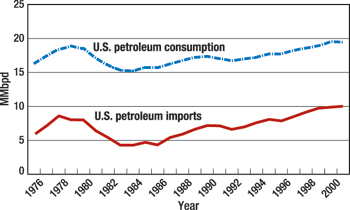Analysis of the increasing U.S. dependence on imported oil
Supply & DemandAnalysis of the increasing U.S. dependence on imported oilWould it be feasible for Canada, Mexico, Saudi Arabia and Venezuela to supply imports to the U.S. of about 10 MMbpd?John R. Moroney, Texas A&M University, College Station, Texas The United States now harbors 5% of the world’s population, but consumes 26% of the world’s petroleum. The reasons why it consumes so much are straightforward. First, petroleum products are less expensive in the U.S. than elsewhere. Second, U.S. per-capita income is the highest in the world – about five times the world average. With current technology, a wealthy nation requires a great deal of petroleum for manufacturing, for producing electricity and, particularly, for transportation. Since 1975, the U.S. has consumed far more petroleum than it produced. The gap between domestic consumption and production must, of course, be filled by imports. Crude oil accounts for about 80% of all imported petroleum. The remaining 20% comprises distillate fuel oil, jet fuel, liquefied petroleum gases, gasoline and gasoline blending compounds, residual fuel oil and other products. Increasing import dependency. Total U.S. petroleum consumption and imports, 1975 to 2000, are shown in the accompanying figure. Apart from a decline between 1977 and 1982, attributable to sharply rising oil prices, both follow a steady upward path. And both will continue to increase for at least the next 20 or 30 years. The important point is that the U.S. will depend increasingly on imported petroleum. Is this increasing dependence on imports inevitable? And, if so, where will the imports come from? The U.S. must rely increasingly on imports because its domestic reserves are too small to support its high rates of consumption. In fact, only about 2% of the world’s known crude oil reserves are in the U.S. and its offshore waters. It is economically efficient for the U.S. to import larger volumes because petroleum is cheaper to produce abroad and import than to produce domestically. The major, integrated U.S. energy firms that produce within the country and abroad reported that average costs of finding and producing a barrel of oil, 1996 to 1998, were $6.47 in the U.S.; $2.71 in the Middle East; and $2.34 in the Western Hemisphere, outside the U.S. and Canada. For this reason, it makes sense for U.S. firms to increase exploration and production abroad.
"Reliable" importing countries. In 2000, the U.S. consumed 19.7 MMbpd of petroleum and petroleum products. Of this total, 10.42 MMbpd were imported. From the viewpoint of national security, it makes sense to ensure that these imports are from reliable sources. In 2000, the U.S. imported 1.37 MMbpd from Mexico, 1.81 MMbpd from Canada, 1.57 MMbpd from Saudi Arabia and 1.55 MMbpd from Venezuela, or 6.30 MMbpd from the four. Canada and Mexico are politically and geographically reliable sources of imports. Barring major political turmoil in Venezuela and the Middle East, both Venezuela and Saudi Arabia seem to be reasonably reliable. So would it be feasible for Canada, Mexico, Saudi Arabia and Venezuela to supply imports to the U.S. of about 10 MMbpd? Probably not, unless production in Canada, Mexico and Venezuela were to substantially increase. Canada’s current production of 2.15 MMbopd is unlikely to expand much in the next few years. Mexico is a different story. According to Pemex estimates, Mexico’s crude oil reserves exceed those in the U.S. If Pemex were to enter joint ventures with foreign firms to expand production, Mexico’s production and exports could probably be increased promptly by 2 MMbopd. And if production quotas were lifted by OPEC, Venezuela might be able to expand production to 3.8 or 4.0 MMbopd, from 2.6 MMbopd. To import 10 MMbopd is an economically efficient, but politically risky business. To conclude: The U.S. will continue to rely heavily on imported crude oil and petroleum products. The nation’s long-run economic and political interests are best served if these imports are reasonably secure. Political stability in the Middle East and Latin America are essential to this security. The Middle East is now a political powder keg.
|
||||||||||
- Prices and governmental policies combine to stymie Canadian upstream growth (February 2024)
- U.S. producing gas wells increase despite low prices (February 2024)
- U.S. drilling: More of the same expected (February 2024)
- U.S. oil and natural gas production hits record highs (February 2024)
- U.S. upstream muddles along, with an eye toward 2024 (September 2023)
- Canada's upstream soldiers on despite governmental interference (September 2023)




